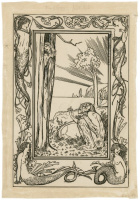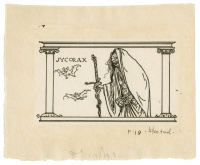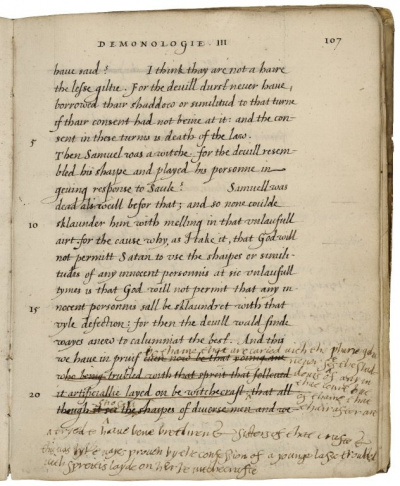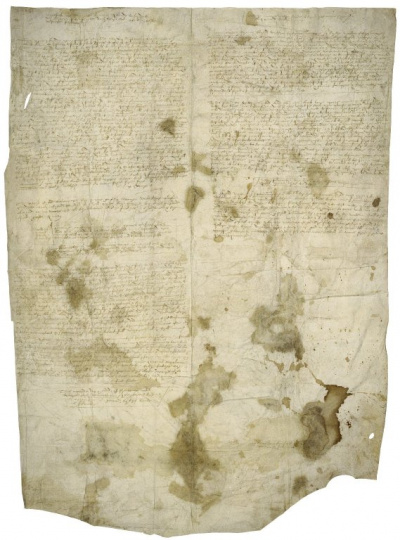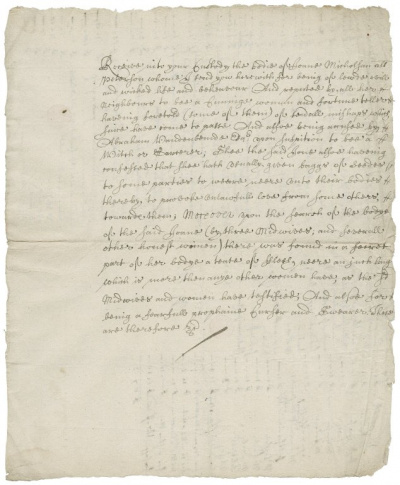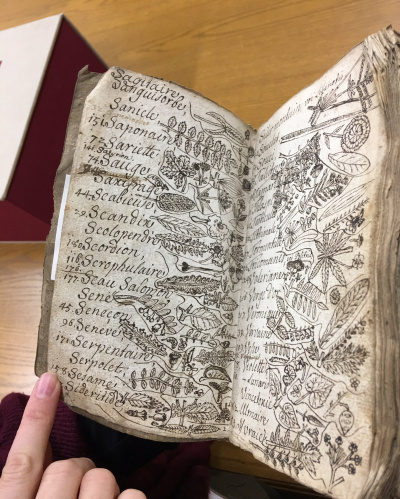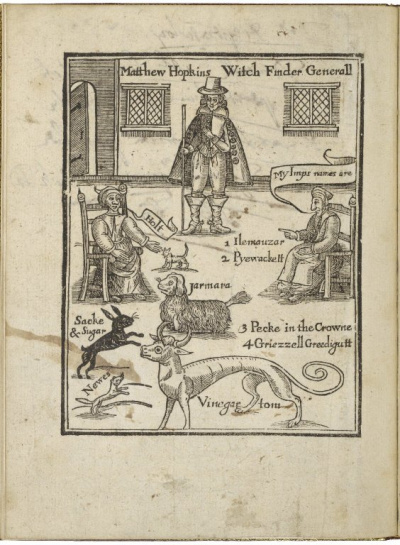I Put a Spell on You (2019)
Part of the O.B. Hardison Poetry Series, I Put a Spell on You featured poets Annie Finch and Kiki Petrosino reading from their work in the Folger's Elizabethan Theatre on October 28, 2019 at 7:30pm. The two poets explored the realms of witchcraft and womanhood in all seasons of life.
The reading was preceded by a pop-up exhibition in the Paster Reading Room, which featured items from the Folger collections releated to witches, witchcraft, spells, and magic. The pop-up was curated by Teri Cross-Davis, Poetry Coordinator, and Beth DeBold, Assistant Curator of Collections. For more information on this past event, please visit the event page.
The exhibition catalog is available for download as a PDF file.
Items included
1). Shakespeare, William, 1564-1616

Mr VVilliam Shakespeares Comedies, Histories, & Tragedies: Published According to the True Originall Copies.
London: Isaac Jaggard and Ed. Blount, 1623
Call Number: STC 22273 Fo.1 no.72
Binding images for STC 22273 Fo.1 no.72
After William Shakespeare died in 1616, two friends from his acting company put together the history-making book that's best known as the "First Folio" of Shakespeare. Published in 1623, seven years after his death, it contains 36 of Shakespeare’s plays---almost all of them. Eighteen of the plays, including Macbeth and Twelfth Night, had never been published before and may have been lost without the creation of the First Folio. Largely because of this book we know them all. A “folio” was a large, expensive book, usually reserved for Bibles or important works of history, law, and science--- not plays. Shakespeare was one of the first English playwrights to have his plays collected in a folio.
The Folger owns 82 copies of this first printed edition of Shakespeare’s works. This copy once belonged to Rachell Paule, a woman living in 17th-century London.
Text by Caroline Duroselle-Melish
2). Bell, Robert Anning, 1863-1933
Trio of illustrations from Bell’s edition of The Tempest
[1900]
Call Numbers:
ART Box B433 no.7 (size S)
ART Box B433 no.10 (size S)
ART Box B433 no.20 (size S)
Although many of Shakespeare’s plays feature magic and the supernatural, The Tempest is the only one to deal so directly with characters who are human practitioners of magic. These original pen and ink illustrations were made by Bell for his edition of the play, published in 1901. We never meet the witch Sycorax in the real time of the play, but she casts a long shadow—the dead mother of the monstrous Caliban, her wickedness and depravity in her use of magic make her the perfect foil for the supposedly beneficent sorcerer Prospero.
Here, Caliban is portrayed as half fish, half man—reminiscent of a sea monster. In Bell’s Frontispiece to Act I, we see him before the arrival of Prospero on the island and his subsequent enslavement, sitting with the spirit Ariel who has been imprisoned in a pine tree by Sycorax. Bell also provides us with an illustration of the witch, described in the play as a “blue-eyed hag.” Contrast the two with Bell’s depiction of a freed Ariel. Scholars have long noted the racialized and gendered tensions present in the play, which was written in 1611, at the beginning of England’s colonial depredations in the Caribbean. These themes, as well as the tensions present in Bell’s early twentieth century, are evident in these illustrations.
Sycorax and Caliban are two characters that have lived rich lives outside the bounds of Shakespeare’s words, inspiring novels, plays, poems, and art from the 19th century on.
3). Rhead, Louis, 1857-1926
[Ariel on a bat’s back]
[before 1918]
Call Number: ART Box R469 no.108 (size L)

Ariel, the lively spirit who is freed from the witch Sycorax only to be bound by the sorcerer Prospero in Shakespeare’s The Tempest, has long been an inspiration for artists. In Act V, Prospero asks Ariel to help attire him in preparation for his final confrontation with Antonio, Sebastian, and Gonzalo. He promises that once this final reckoning is made, Ariel will be free from his magical bonds. In response, Ariel sings:
Where the bee sucks, there suck I,
In a cowslip’s bell I lie;
There I couch when owls do cry;
On the bat’s back I do fly
After summer merrily.
Merrily, merrily shall I live now
Under the blossom that hangs on the bough.
(Act V, sc.i 98-104)
This watercolor illustration was painted by artist Louis Rhead in preparation for a 1918 edition of Charles and Mary Lamb’s Tales from Shakespeare. This popular and often-reprinted volume offered prose retellings of Shakespeare’s plays, and was primarily meant for children.
4). Trotter, Thomas, printmaker, 1756-1803; after Henry Fuseli, painter, 1741-1825
[The Witches appear to Macbeth and Banquo]
London : J. & J. Boydell, 1790
Call Number: ART Box F993 no.9 (size XL)
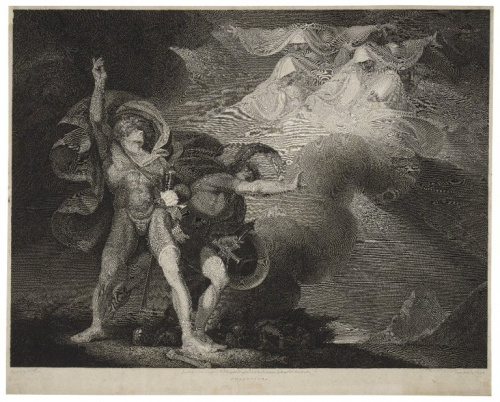
In this vivid depiction of Macbeth and Banquo’s encounter with the three Weïrd Sisters on the blasted heath, we are thrown into the chaotic moment at which Macbeth learns his fate: the three sisters cry “hail,” telling him that he shall be Thane of Cawdor, and king thereafter. Troublingly, they also prophesy that Banquo “shalt get kings, though [he] be none.” Shortly after, the two are met by King Duncan’s men, who hail Macbeth as Thane of Cawdor. Macbeth begins to wonder if, since this part of the prophecy was true, how the rest might be fulfilled. From this one moment, his path is set towards the inevitable: murder, doom, and ruin.
Henry Fuseli, a Swiss-born painter who lived in England for much of his life, was captivated by the macabre and supernatural. In 1786 he was commissioned to paint scenes from different Shakespeare plays for engraver and publisher John Boydell’s famous and ill-fated “Shakespeare Gallery.” Meant to foster British art and create a large, lavishly illustrated folio edition of the plays, as well as engraved reproductions of the paintings for sale, the gallery ended up being a financial failure—but it had an enormous influence on the public, perceptions of Shakespeare, and how art was made and consumed in Britain. This engraving is a proof, prepared for a print that was never published.
The Folger owns several original Fuseli paintings, including depictions of Ariel, Puck, “Faery Mab,” and “Macbeth Consulting the Vision of the Armed Head.” These are currently on display in the Bond Reading Room, along with other works of art from the Folger collections.
5.) Scholder, Fritz, 1937-2005
One of Three
1995
Call Number: ART 240183 (size L)
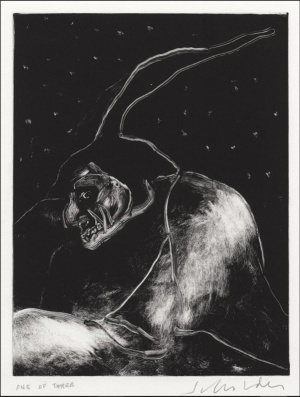
This gorgeous monotype depicts “one of three” witches from Macbeth. Clad in a horned helmet and thick cloak, thick tusks sprouting up from her lower jaw, the witch gazes back at us out of the corner of one eye from under a carpet of stars.
Montoype prints are a magic in and of themselves—they are created by painting in reverse on a glass or acrylic plate with ink, or by covering the plate in ink and then removing the portions meant to be negative space. A single print is then made using a press. The result is one-of-a-kind, and can never be repeated in quite the same way again. Monotypes are particularly prized for their velvety, textured quality. Sometimes a single print will pass through the press multiple times as color and lines are added.
Scholder’s creation here captures the shivery delight often evoked by the Weïrd Sisters…and makes us wonder what the other two are up to in the meantime.
6.) Unknown
An paramount for to get the love of a woman [and two other spells]
England: [1600]
Call Number: X.d.208
High-resolution Digital Images of X.d.208
<gallerywidths="200px" heights="200px">
File:Xd2801r.jpg|X.d.208 1r
File:Xd2801v.jpg|X.d.208 1v
File:Xd2802r.jpg|X.d.208 2r
File:X.d.2802v.jpg|X.d.208 2v
</gallery>
This document includes several spells, including a spell to “get the love of a woman,” “To know when a woman is w[i]th a man chylde or a woman chylde,” and “To know whether newes be trow or false.”
The first and lengthiest spell instructs the bearer in how to conduct a coercive love spell. First, the person wishing to use the spell must draw the image “of ^a woman her whom thow doste love / or whom thow wylte haue” on a blank tile on a Friday. The caster must then offer specific words and prayers to both Venus and God. The spell gives helpful guidance in how to draw the object of the person’s desire, along with specific symbols to include, where to place them, and what they mean. If the worker of this spell is successful, the woman will have “nether reste in slyppynge nether wakynge…lyenge nether standdynge nether settynge & how so ever she move that so she maye burne in the love [of him] & that she maye so thynke vppon hym contynyally wth owte sessynge, where by she maye com & full fyll his wysh & re queste in all thynges…”
Text and transcription by Beth DeBold and Heather Wolfe
7). Unknown
Book of Magic, with instructions for invoking spirits…
England: [1577-1583?]
Call Number: V.b.26 (1) and (2)
Cover-to-cover digital images of V.b.26 (1)
Cover-to-cover digital images of V.b.26 (2)
The Book of magic, ca.1577–1583 V.b.26, page 51
<gallerywidths="200px" heights="200px">
File:Vb26 1 p164.jpg|V.b.26 (1), p.164
File:Vb26 1 p165.jpg|V.b.26 (1), p.165
File:Vb26 2 p206.jpg|V.b.26 (2), p.206
</gallery>
This grimoire contains detailed instructions for invoking spirits and casting spells. Through the magic of various invocations, the user could cure sickness, catch thieves, or find love. The manuscript was well-used: successive generations of readers added notes to the margins, and one user supplied page numbers in a distinctive blue ink. In the early nineteenth century, the first fourteen pages and the final thirty pages were removed, and the Folger Shakespeare Library purchased this incomplete version of the manuscript in 1958. We were able to add the missing final pages to the collection after successfully bidding on them at a 2007 auction in London. This ‘lost’ portion of the grimoire was identifiable by its blue page numbers and other external and internal evidence. We are still searching for pages one to fourteen.
Magic circles were drawn on the ground or on a piece of parchment in order to summon angels, spirits, or demons to assist the magician with his work. In the volume to your left, V.b.26 (1), the two circles are to be used to summon the spirit Birto “to make aunswere to any Question to be demaunded” on the second, fourth, sixth, tenth, or twelfth day of the month, when the air is clear. The summoner was instructed to sit in the right-hand circle on his knees and repeat three times the provided prayer, psalm, and conjuration. Birto would then appear in the form of a man in the other circle. On the opposite page, instructions in Latin are written for summoning a spirit named Bilgall.
In V.b.26 (2), to your right, the ABRACADABRA spell appears on the bottom of page 206, the first page of the last part of the manuscript which the Folger acquired in 2007. A magician could cure a sick person without that person’s knowledge by each day scraping out successive lines of the word ABRACADABRA, written on virgin parchment, while reciting the provided spell.
Text by Heather Wolfe
8). James I/VI, 1566-1625
Daemonologie in form of a dialogue [manuscript]
[1592]
Call Number: V.a.185
Select Images of V.a.185
This manuscript is a fair copy of a treatise written by King James I/VI on witchcraft and demonology. He was quite interested in the supernatural, and when in 1590 it was revealed that several witches in North Berwick (just east of Edinburgh) had made attempts on his life, he traveled to both attend the trials and interrogate the witches himself. Daemonologie follows the form of a conversation between two fictional individuals, “Philomathes” and “Epistemon,” who debate what is known about witchcraft. It was published in 1597, and issued three times in London on his accession to the throne in 1603. It was also made available in Latin and Dutch for international audiences. Daemonologie also pushes back against those who doubt the existance of witches, particularly the author Reginald Scot, whose book The Discoverie of Witchcraft (1584) characterized belief in supernatural phenomena and witchcraft as irrational. In his text, James criticizes Scot roundly, his book was banned, and copies burned.
This scribal copy of Daemonologie has been attributed to James’s childhood friend Sir James Semphill, and contains corrections in the hand of the monarch himself.
Text by Heather Wolfe and Beth DeBold
9.) Unknown
Spell to bind the seven sisters of the fairies to you for ever
England: circa 1600
Call Number: X.d.234
High-res Digital image of front side of X.d.234
Written on vellum, this highly unusual and unique set of four spells instructs the bearer in how to summon and bind the fairies Lilia, Hestillia, Fata, Sola, Afrya, Africa, Julia, and Venulla. The first spell gives instructions for calling the fairies, the second another set of instructions for marking a circle and calling individual fairies to you, the third for binding them once they are in your presence, and the fourth to banish them. The reason for calling the fairies is explicitly for sexual purposes. This manuscript is considered at length in Dr. Frederika Bain’s article “The Binding of the Fairies: Four Spells," which can be viewed and downloaded here.The article includes full transcriptions.
10.) England and Wales. Court of Quarter Sessions of the Peace.
Warrant from the Middlesex Court of Quarter Sessions of the Peace for imprisonment of Joane Micholson
England: [1675?]
Call Number: X.d.375 (30)
High res Digital Image of X.d.375(30)
This undated warrant provides a glimpse into the process of accusation and arrest on suspicion of witchcraft. The victim’s name is Joan Micholson. The document reads:
Receive into your Custody the bodie of Joane Micholson als
Peterson whome I send yow here with for being of lewde evill
and wicked life and beheavour And reputed by all her
Neighbours to bee a Cunninge woman and fortune teller
haveing foretold (some of them) of sem ill mishaps which
Since have come to passe. And alsoe being accused by
Abraham Pandenbende Esq^r vpon suspition to bee a
Witch or Sorcerer; Shee the said Jone also having
confessed that shee hath usually given baggs of seedes
to some parties to weare neere vnto their bodies
thereby to provoke unlawfull love from some others,
towarde them; Moreover vpon the search of the bodye
of the said Joane (by three Midwives; and several
other honest women) there was found in a secret
part of her bodye a teate of flesh neere an inch long
which is more then anye other woman have, as the s[ai]d
Midwives and women have testified, And alsoe for
being a fearfull prophaine Curser and Swearer, These
and therefore &d./
The narrative hits all the usual marks of a seventeenth-century witchcraft accusation: Joan is able to predict the future; she is known to provide love charms; she curses, swears, and behaves badly; furthermore, when examined by midwives and “honest women,” she is found to have a teat where a familiar or the devil might be expected to come nurse. While most victims accused of witchcraft were women, women also participated heavily in trials as experts on women’s bodies, and participated in accusing their neighbors. Joan’s fate is not known.
11.) Molitor, Ulrich, 1470-1501
De Lamiis et Phitonicis Mulieribus
Germany, circa 1493-1500
Call Numbers:
INC M794
INC M795
INC M803
INC M806
These items have not yet been added to our digital collections
De Lamiis et Phitonicis Mulieribus ("Of witches and diviner women") was an early treatise on witchcraft, which featured some of the first illustrations of witches in European sources. These four books were printed in what is now Germany—two in Latin, and two in the local language.
First published in 1489, De Lamiis is a dialogue between a skeptic (Archduke Sigismund of Austria) and a believer (the author Molitor) in witchcraft. Molitor believed that the Devil had the power to trick people into giving him allegiance, and that most resulting magical phenomena credited as witchcraft were illusions caused by Satan to keep humans in thrall. He did not trust witches who confessed through torture, although he did advocate for the execution of witches as heretics.
The lively woodcuts show witches working weather magic, copulating with a demon (possibly the Devil himself), transforming into evil creatures, and engaging in a sabbath, Such images established the popular idea of what witches looked like, which can still be seen today. These four volumes are on deposit at the Folger through the generosity of Ingrid Rose, in memory of Milton Rose.
12). Napkyn, Hugh, active 1617-1639
A booke conteyning divers excellent & approoved remedyes in phisique and chyrugery…[manuscript]
England: [1631]
Call Number: Fast Acc. 271103
This item has not yet been added to our digital collections
Compiled by Hugh Napkyn, a barber surgeon living in London in the seventeenth century, this elaborate manuscript contains numerous recipes for plasters, balms, waters, and other medical remedies. The cures treat a wide variety of complaints and illnesses, from simple coughs to “cancer in the breast” and the plague. The boundaries between medicine, food, science, and magic were much more porous than we would think of them today: for example, this charm for an Ague, which involves carving mystical characters into two halves of a pippin (a type of apple). The patient is then supposed to eat in a specific way, and Napkyn writes that it has been “prooved [successfully tested] numerous times.” It is perhaps worth mentioning that Napkyn was involved in several medical malpractice suits, but it was not uncommon for medical practitioners to utilize such charms.
Text compiled from dealer description
13.) Unknown
Table des plantes naturelles de l’evêchée des Bâles qui entrent en Medecine…[manuscript]
[Basel]: circa 1700
Call Number: V.a.597, item 1
This item has not yet been added to our digital collections
This beautifully-illustrated French manuscript provides lists of plants found in the “bishopric of Basel,” which can be used for medicinal purposes. In the early modern period, medicine, cookery, magic, and science were more fluid categories than how we think of them today, and manuscript miscellanies such as this one would routinely include recipes to both cure and feed the body. Some recipes may seem less based on scientific logic as we would understand it today, and more like what we would think of as “magic.” The table of detailed illustrations, helpful for recognizing the plants, is followed by an index of common ailments (for example, ulcers, gout, or paralysis) and potentially afflicted body parts (eyes, stomach, intestines). The book further includes descriptions of each plant listed, and its uses. Plants named include ones we would consider both medicinal and culinary, such as Chicory, White and Black Hellebore, Endives, Chamomile, Aniseed, Mint, Vervain, and Sesame. In addition to cures for humans, the manuscript also includes cures for farm animals.
14). Hopkins, Matthew, -1647
The discovery of vvitches : in answer to severall queries, lately delivered to the judges of assize for the county of Norfolk. And now published by Matthevv Hopkins, witch-finder. For the benefit of the whole kingdome.
London : R. Royston, [1647]
Call Number: 144- 461q
Selected Image from 144-461q
One of the best-known periods of panic over witchcraft took place during the English Civil Wars, in the 1640s. Matthew Hopkins, a destitute lawyer, began a short-lived but brutal career as a professional “Witch-finder” in 1644, supposedly after he heard several women in his town discussing their meetings with the Devil. He determined to enforce the Act Against Conjuration, Witchcraft, and dealing with evil or wicked spirits, which had been passed by James I/VI in 1604, and began to travel throughout East Anglia, hunting and trying witches. He is likely responsible for the deaths of as many as 300 people, and since he charged upwards of 20 shillings per town for his services, made a fine living doing so.
His book, The Discovery of Witches, outlines his methods, which drew heavily on King James I/VI’s Daemonologie. Many of these ideas are now enshrined in the lore of witchcraft, and include seeing whether a witch would float in water (the logic being that if a witch had renounced her baptism, she would be physically rejected); whether a witch would bleed if pricked or cut; or if a potential witch was suspected of having a familiar: an evil spirit in the form of an animal that provided the witch with a link to their Satanic master. The frontispiece to this edition of Discovery shows several witches with their familiars. Although a cat was a common familiar, it was understood that familiars could also be other animals, such as rabbits or dogs.
15). Mather, Cotton, 1663-1728
Late memorable providences relating to witchcrafts and possessions : clearly manifesting, not only that there are witches, but that good men (as well as others) may possibly have their lives shortned by such evil instruments of Satan…
London: 1691
Call Number: 178- 918q
This item has not yet been added to our digital collections
Witchcraft was also persecuted in England’s colonies, over the course of the seventeenth century. Cotton Mather, a Puritan minister and the son of a prominent family, was a prolific writer and hugely influential in the moral life of the colonies. His book Memorable Providences, first published in 1689, detailed the demonic possession of several children in Boston. An Irish washerwoman, Ann Glover, was tried and hanged as a witch as a result. Although the children continued to be afflicted after her death, Mather simply saw this as further evidence of the powers of hell. As an eyewitness, Mather studied the behavior of the children, and recorded the proceedings of the trial. His book was later used in the infamous trials at Salem in the 1690s, in which the possessed children exhibited similar afflictions as those that Mather had witnessed. Although he apparently attempted to be a tempering influence, urging general mercy and caution in the use of “spectral evidence,” nineteen individuals were hanged by the end of the crisis in 1693.
16). Porta, Giambattista della, approx. 1535-1615
Natural Magick: by John Baptista Porta, a Neapolit.ane: in twenty books…
London: 1658
Call Number: [http://hamnet.folger.edu/cgi-bin/Pwebrecon.cgi?BBID=152245 144- 662f
This item has not yet been added to our digital collections
Books of Magic, or Books of Secrets, were written and published openly from the beginning in Western Europe. These texts combined ideas we would now think of as science with what we would think of as religious or magical ideas. Magic was accepted as a general fact of life by most early modern people, but one that was firmly in line with the Christian understanding of the universe. To deny demonic influence, just like denying divine influence, would have been unacceptable. But that did not mean practicing “bad” magic was permissible. Porta, along with many practitioners writing on “magic,” was quite clear about the distinctions, and sets out at the beginning of his text to ensure that his readers understand the difference:
There are two sorts of Magick: the one is infamous, and unhappie, because it hath to do with foul spirits, and consists of Inchantments and wicked Curiosity; and this is called Sorcery; an art which all learned and good men detest; neither is it able to yield any truth of Reason or Nature, but stands merely upon fancies and imaginations, such as vanish presently away, and leave nothing behinde them...the other Magick is natural, which all excellent wise men do admit and embrace, and worship with great applause; neither is there anything more highly esteemed, or better thought of, by men of learning…
First published in Naples in 1558, this English translation includes subjects such as metallurgy, optics, cooking, geomancy (or telling the future by reading stones), astrology, medicines, and more. In addition to how to grow certain plants, deal with physical ailments, create make-up, and breed farm animals, the text includes recipes for how to “counterfeit sicknesse,” how to make fake versions of precious stones, how to freshen one’s armpits, how to dye one’s hair red, and even a recipe for tricking women into removing their clothing.
17). Indagine, Johannes ab, -1537
Briefe introductions, bothe naturall, pleasaunte, and also delectable vnto the art of chiromancy, or manuel diuination, and physiognomy…
London: 1558
Call Number: STC 14075
This item has not yet been added to our digital collections
This English translation of Chiromantia instructs the reader in the art of palmistry, otherwise known as “chiromancy.” Along with astrology and physiognomy, palm-reading was commonly accepted as a means to answer questions about a person’s life, character, and future. The woodcut illustrations highlight different parts of the palm, and discuss to which astrological house each is related; how lines may be formed and what different formations mean; and how to interpret these generally. The book was enormously popular, going through multiple print editions and translated into many different languages.
18). Lancre, Pierre de, -1537
Tableau de l’inconstance des mauuais anges et demons…
Paris: 1612
Call Number: 176- 711q
Select Image from 176- 711q
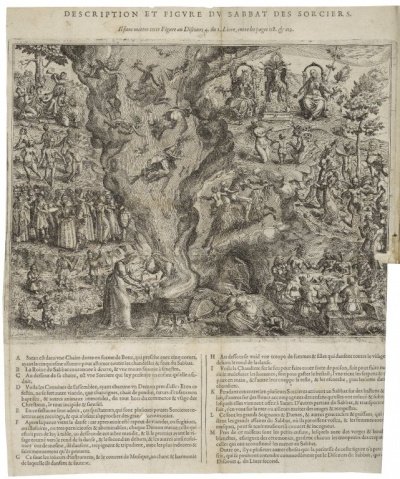
Pierre de Lancre was a French judge who was commissioned by the French king Henri IV to investigate witches and witchcraft in the Basque region of Labourd in 1609. His book, Portrait of the Inconstancy of Witches, exemplifies much of the anxiety in the early seventeenth century over “Other”-ness, women, and sexuality.
Lancre devotes a particularly large portion of his work to a detailed description of the witches’ Sabbath, which is both deeply eroticized and pulls on sensationalized ideas about demonological habits, such as eating children, infernal copulation, and dancing. The Sabbath is shown here in an elaborate fold-out plate at the beginning of the work, where all of these activities are depicted.
19). Heywood, Thomas, 1574-1641
The late Lancashire vvitches. : A well received comedy, lately acted at the Globe on the Banke-side, by the Kings Majesties Actors.
London: 1634
Call Number: STC 13373
This item has not yet been added to our digital collections
Thomas Heywood, a contemporary of Shakespeare’s, wrote this play in response to a spate of trials for witchcraft that took place in the area surrounding Pendle Hill in Lancashire in 1612 and 1633. Twelve people were accused in 1612, the result of local intrigue, disagreements, and families at odds with one another. It was one of the best-documented trials of its time, and resulted in much public commentary and speculation. One of the most shocking aspects was that the key witness, a nine-year-old girl named Jennet Device, denounced her entire immediate family as well as her neighbors. Nine people were sent to the gallows, including her grandmother, mother, brother, and sister. Those familiar with Neil Gaiman and Terry Pratchett’s Good Omens may recognize another victim of the Pendle trials has a familiar-sounding name: Alice Nutter.
In 1633, Jennet was among a group of twenty witches accused by a young boy. They were convicted, but in the intervening twenty years, higher standards of proof had begun to be demanded. Ultimately only four women were sent to be examined by the Privy Council, and all were pardoned when the boy admitted his accusations were false.
Heywood and his co-author, Richard Broome, capitalized on public fascination with the trial, and completed the work before the examinations were complete. Their play ends assuming the guilt of the witches in the epilogue:
Now while the Witches must expect their due
By lawfull Justice, we appeale to you
For favourable censure; what their crime
May bring upon 'em, ripenes yet of time
Has not reveal'd. Perhaps great Mercy may
After just condemnation give them day
Of longer life. We represent as much
As they have done, before Lawes hand did touch
Upon their guilt; But dare not hold it fit,
That we for Justices and Judges sit.
And personate their grave wisedomes on the Stage
Whom we are bound to honour; No, the Age
Allowes it not. Therefore unto the Lawes
We can but bring the Witches and their cause,
And there we leave 'em, as their Divels did,
Should we goe further with 'em? Wit forbid;
What of their storie, further shall ensue,
We must referre to time, ourselves to you.


